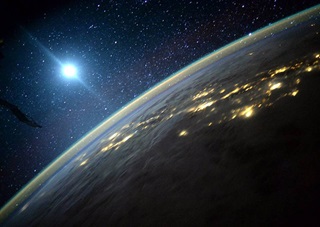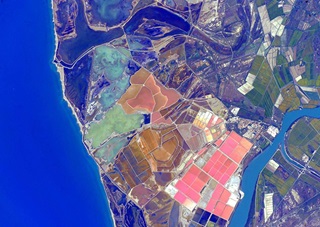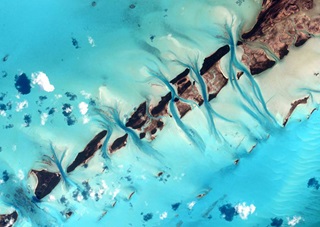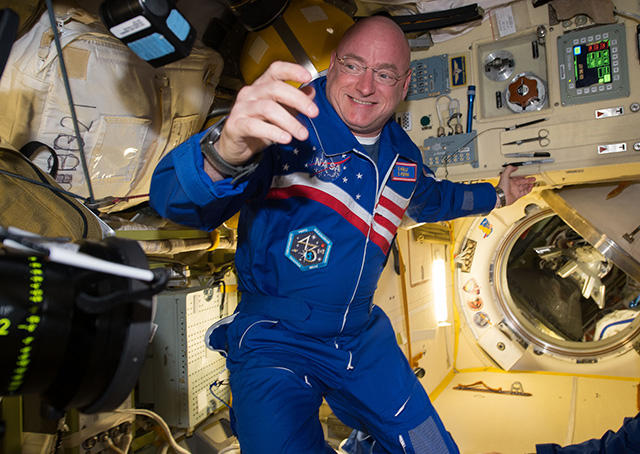

When he returned to Earth after spending a U.S. record of 340 consecutive days in outer space (and 520 for his career), NASA astronaut Scott Kelly said he was a little bit taller, a wee bit wobbly, and longing for a fresh salad.
Kelly’s time aboard the International Space Station was twice the length of a typical mission, and designed in part to measure the effects of such a long time spent beyond gravity on Kelly, who happens to have a twin brother, Mark, a retired NASA space shuttle pilot.
A Soyuz capsule with Kelly, along with Russian cosmonauts Mikhail Kornienko and Sergey Volkov, parachuted to a landing March 2 in the Kazakh city of Zhezkazgan, less than four hours after departing the space station. Kelly waved energetically after emerging from the capsule. After touching down on U.S. soil at Ellington Field near the Johnson Space Center in Houston March 3, he was welcomed by a crowd that included Jill Biden, the wife of the vice president, who offered him beer and apple pie, according the Reuters news service.
In a news release welcoming the long-endurance astronaut back home, the space agency said Kelly’s nearly one-year orbit will allow researchers to better understand how the human body reacts and adapts to long-duration spaceflight. NASA says the information is critical as the agency “looks toward human journeys deeper into the solar system, including to and from Mars.”
Kelly spent 520 days in space across four missions, by far the most time logged in space for a U.S. astronaut. That record, however, is in peril, with the planned March 18 launch of fellow long-endurance astronaut Jeff Williams, who plans to make space his home long enough to reach 534 days for his career. That will surpass Kelly but still be short of the world record held by Volkov, who rode back to Earth with Kelly having logged 548 days over three flights.
For his part, Kelly, 52, was cheerful and direct as he greeted a room full of scientists and reporters at the space center for a live news conference peppered with personal and scientific questions.
Because Scott and Mark Kelly are both physically fit, NASA said there will be much learned from studying them that benefits future space travelers. Mark Kelly spent 54 days in outer space on four NASA missions and piloted the space shuttle Endeavour to its own retirement.
Scientists said Kelly grew two inches taller while in space. In the absence of gravity the disks in vertebra spring up and absorb fluids, so astronauts temporarily get a little bit taller, enough to affect spacesuit fit. When they return to Earth, however, the phenomenon quickly dissipates.
 Kelly has participated in a variety of research efforts that will help scientists better understand how the human body adapts to long-duration spaceflight. That knowledge will play a critical role in future missions deeper into the solar system, including the journey to Mars, in which a round trip is likely to last 500 days or longer. Bone density, muscle elasticity, exercise, and psychological changes are some of the items that will be studied. NASA said researchers are also interested in the effects of extended exposure to radiation above the earth’s atmosphere, and its impact on cancer.
Kelly has participated in a variety of research efforts that will help scientists better understand how the human body adapts to long-duration spaceflight. That knowledge will play a critical role in future missions deeper into the solar system, including the journey to Mars, in which a round trip is likely to last 500 days or longer. Bone density, muscle elasticity, exercise, and psychological changes are some of the items that will be studied. NASA said researchers are also interested in the effects of extended exposure to radiation above the earth’s atmosphere, and its impact on cancer.
Kelly has more than a million Twitter followers, and he used the social site to post a dramatic series of photos of Earth’s surface features: Sand dunes, the Himalaya Mountains, and even the massive January snowstorm that blanketed the East Coast were all subjects for Kelly’s Nikon cameras and telephoto lenses.
The astronaut also enamored himself to television viewers with his candid live appearances on The Late Show with Stephen Colbert. Some of his insight on extended space travel, however, was surprisingly mundane.
For instance, Kelly said he used a simple watch to tell him when it was time to go to bed. “It takes us 90 minutes, 16 times a day [to orbit Earth],” he told Colbert in January. “We just use a watch to tell the time and when its 10:30, it’s time to go to bed. Sometimes simple things like this work pretty well up here.”

Colbert was taken aback when Kelly suggested life without bones: “If you lived here for a great amount of time you wouldn’t need bones, really, to hold your meat,” Kelly said. “If you lived here forever you’d have no reason to have much of a skeleton.”
During a Facebook chat after his return, Kelly was candid about some of the things he missed in his year-long absence from the planet Earth, and he had other key observations:
- He longed for a dip in a swimming pool: “I didn’t have any kind of running water in a year. There was nothing like jumping in a pool of water, it felt great.”
- A bed: “It’s kind of painful, actually. Your body does not respond that well to gravity, after not having it for so long.”
- Food: “It’s kind of funny. The first thing I ate was a banana and as soon as I ate it I recognized the irony in that. The first thing I wanted to eat was salad. It’s a pretty hectic time when you come back to earth so the memory is not all that clear.”
- Daily living conditions: “I probably spent like five months in that little box. The point I’m trying to make is that if you are going to Mars, having that space that you spend so much time in is very, very important, and you need to make it as perfect as you can—the air, temperature, entertainment, noise abatement.”
- Current events: “I asked my flight doc how Super Tuesday went. I had the news on all the time so you’re always kind of listening to it. The audio indication of the Ku-band link actually serves a dual role keeping you connected to what’s happening on earth and as well as its communications role (in space).”
- Breaking a space record: “Records are made to be broken. Pushing the envelope is what makes society progress. I’m just privileged to be here.”
- Key takeaways: “I think space is important. It helps the economy grow and it improves technology. They never imagined how important that stuff would be to our future. I think it’s great that it’s renewed interest in space.”
- Insights about planet Earth? “You can see parts of pollution over Southeast Asia, the fires over southern California, and weather systems in areas where they aren’t normally [located]. For us to take care of the air we breathe and the water we drink is critical. And I do believe we have an impact on that and the ability to change that if we make the decision to.”
Kelly said he wasn’t aware that his record-breaking journey had rekindled an interest in American space travel and he indicated he wasn’t quite ready to hang up his spacesuit and helmet just yet.
“I’ll never be done with space, I’ll always be involved,” he said to close the news briefing. “I doubt I would fly again with NASA, after having the most time in space by any American. We have so many talented professionals in our office there’s no reason for fly me again, but I absolutely wouldn’t say that I’m 100 percent done. Maybe in the next 20 years you’ll be able to buy a cheap ticket and go for a little visit.”




